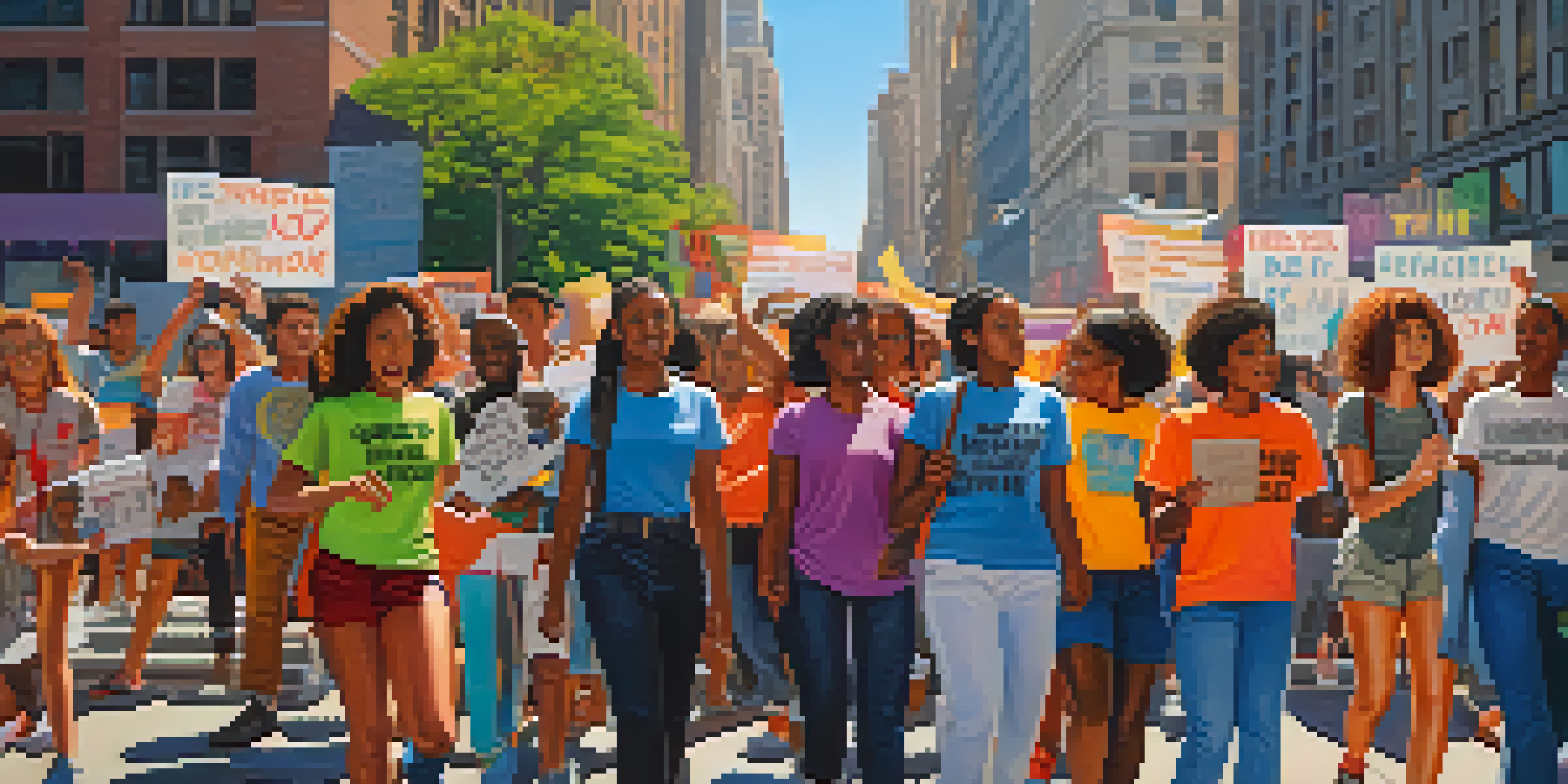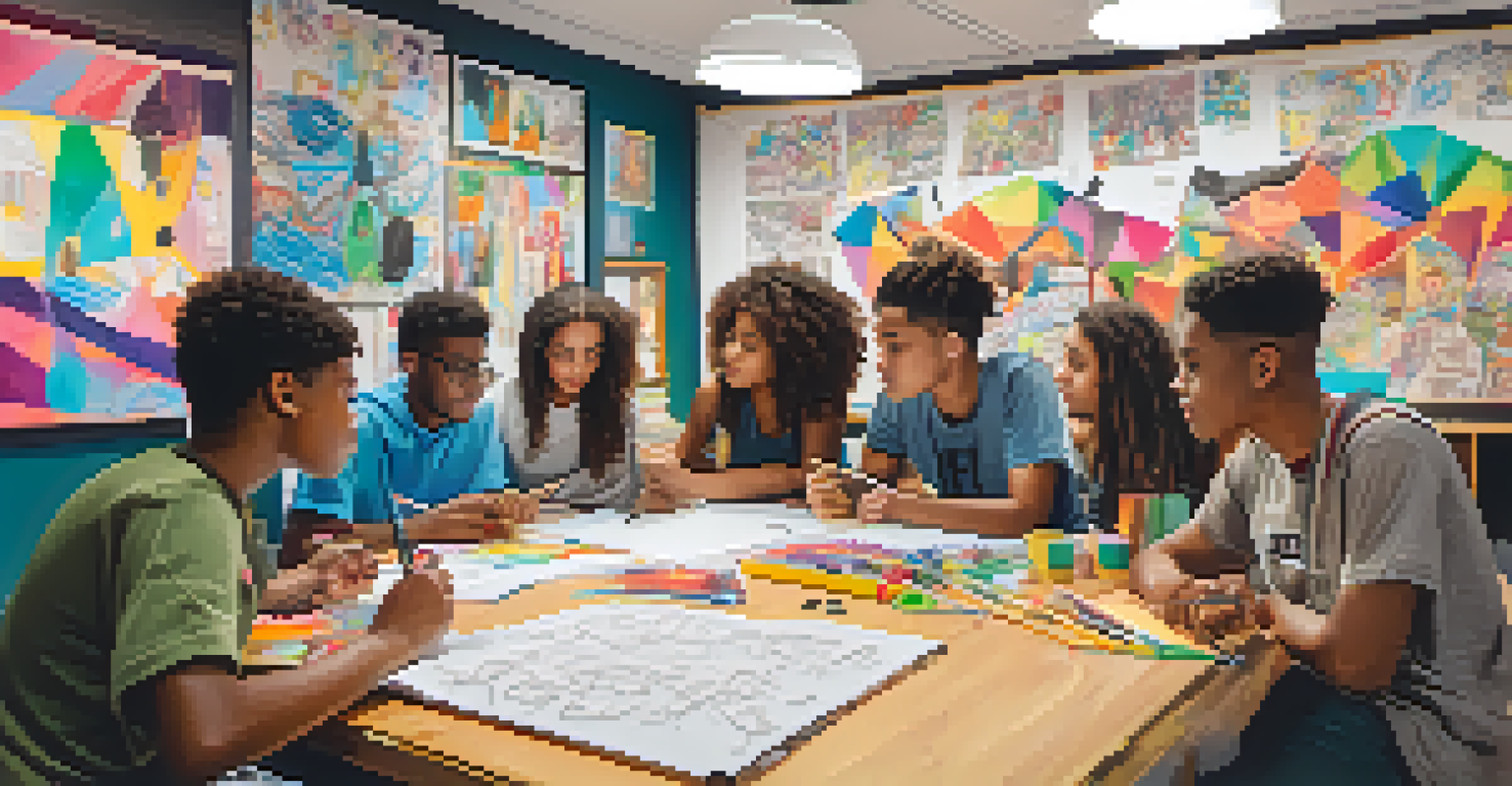Youth Activism in NYC: A Historical Overview of Key Movements

The Roots of Youth Activism in New York City
Youth activism in New York City has deep historical roots, dating back to the early 20th century. Young people began to organize around issues such as labor rights and women's suffrage, recognizing their power to influence change. These movements set the stage for future generations, showing that youth could be a significant force in society.
The future belongs to those who believe in the beauty of their dreams.
In the 1960s, the Civil Rights Movement inspired many young New Yorkers to fight for equality and justice. High school students joined protests, advocating for desegregation and social change in their communities. This era marked a pivotal moment, as youth began to see themselves as active participants in shaping their world.
The spirit of activism continued to grow as young people began to leverage new forms of communication, especially through music and art. These creative outlets allowed them to express their passions and rally others to their causes, building a vibrant culture of activism that remains vital today.
The Impact of the Stonewall Riots on Youth Activism
The Stonewall Riots of 1969 were a watershed moment for LGBTQ+ rights, deeply influencing youth activism in NYC. Young people played crucial roles in the riots, standing up against police brutality and discrimination. This event empowered a generation to advocate for their rights and led to the formation of numerous youth-led LGBTQ+ organizations.

Following Stonewall, the annual Pride Parade became a significant platform for youth to voice their demands for equality. Young activists organized rallies, marches, and educational campaigns, fostering a sense of community and solidarity. Their efforts not only advanced LGBTQ+ rights but also inspired young people in other social justice movements.
Youth Activism's Historical Roots
Youth activism in NYC has a rich history, beginning with movements for labor rights and women's suffrage that empowered generations to advocate for social change.
As the LGBTQ+ rights movement evolved, so too did the strategies employed by youth activists. They embraced technology and social media, using these tools to spread awareness and mobilize supporters quickly. This adaptability continues to characterize youth activism in NYC, showcasing their resilience and innovation.
The Role of Youth in Environmental Activism
In recent years, environmental issues have sparked a new wave of youth activism in New York City. Young people have been at the forefront of movements advocating for climate action, pushing for policies that prioritize sustainability and environmental justice. Their passion and urgency reflect a growing awareness of the impact of climate change on future generations.
Youth is the hope of our future.
One of the most prominent examples is the youth-led school strikes for climate action, inspired by activist Greta Thunberg. NYC students organized walkouts, demanding that leaders take meaningful steps to address the climate crisis. These strikes not only drew attention to environmental issues but also empowered young people to realize their agency in effecting change.
The collaboration between youth activists and established environmental organizations has strengthened their impact. By working together, they amplify their voices and create a unified front in the fight against climate change. This partnership showcases the importance of youth involvement in shaping policies that affect their futures.
Youth Activism and Social Justice Movements
Youth activism has played a significant role in social justice movements throughout NYC's history. From the Black Lives Matter movement to campaigns against police brutality, young people have been instrumental in advocating for equity and justice. Their determination and commitment to these causes highlight the essential role of youth in shaping a fairer society.
In 2020, following the murder of George Floyd, NYC youth took to the streets in massive protests. They organized rallies, created art, and used social media to raise awareness about systemic racism. These actions not only demonstrated their solidarity with the Black Lives Matter movement but also reignited conversations about race and justice in America.
Impact of Technology on Activism
The rise of technology and social media has revolutionized youth activism, enabling quick mobilization and broader outreach for social justice causes.
By centering their activism around social justice, young people are not only challenging existing power structures but also envisioning a more inclusive future. Their efforts emphasize the interconnectedness of various social issues, showing that the fight for justice is a collective endeavor that demands diverse voices and perspectives.
The Influence of Technology on Youth Activism
Technology has transformed the landscape of youth activism, providing new avenues for engagement and organizing. Social media platforms allow young activists to connect, share ideas, and mobilize quickly, reaching a broader audience than ever before. This digital age has empowered youth to amplify their voices and advocate for change on a global scale.
Hashtags like #BlackLivesMatter and #FridaysForFuture have become rallying cries, uniting young people across borders. These online movements often translate into real-world action, as seen in protests and advocacy campaigns. The ability to share information instantly has created a sense of urgency and solidarity among youth activists.
While technology offers powerful tools for activism, it also presents challenges, such as misinformation and online harassment. Young activists must navigate these obstacles while remaining committed to their causes. Their resilience in the face of these challenges demonstrates their dedication to creating a better world.
The Importance of Intersectionality in Youth Movements
As youth activism in NYC continues to evolve, the concept of intersectionality has become increasingly important. This approach recognizes that individuals experience overlapping forms of oppression based on race, gender, sexuality, and socioeconomic status. By embracing intersectionality, young activists can create more inclusive movements that address the diverse needs of their communities.
For example, youth-led movements often incorporate issues such as racial justice, gender equality, and environmental sustainability. This holistic approach allows activists to understand the interconnectedness of these issues and advocate for comprehensive solutions. By working together, young people can build a stronger, more united front for social change.
Embracing Intersectionality Matters
Recognizing intersectionality within youth movements fosters inclusivity and strengthens advocacy by addressing the diverse needs of different communities.
Moreover, recognizing intersectionality helps to elevate marginalized voices within youth movements. It encourages young activists to listen to and uplift those whose experiences may differ from their own. This commitment to inclusivity strengthens the movement as a whole, fostering a sense of belonging and solidarity among all participants.
Looking Ahead: The Future of Youth Activism in NYC
As we look to the future, the legacy of youth activism in NYC serves as a powerful reminder of the potential for change. With each new generation, young activists bring fresh ideas, perspectives, and strategies that challenge the status quo. Their passion for social justice and equality ensures that the fight for a better world will continue.
The ongoing challenges of climate change, systemic racism, and social inequality demand the energy and creativity of youth. By engaging in activism, young people not only address these pressing issues but also inspire their peers to take action. This ripple effect fosters a culture of activism that is vital for driving meaningful change.

Ultimately, the future of youth activism in NYC is bright. As young people continue to harness their collective power and embrace innovative approaches, they will undoubtedly shape the landscape of social justice for years to come. Their voices, ideas, and determination will be key to creating a more just and equitable society.